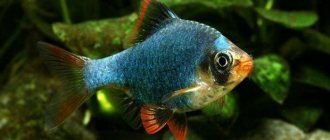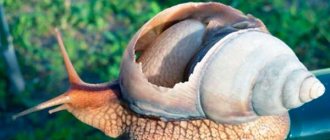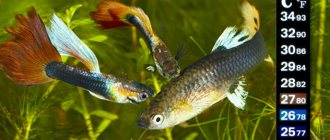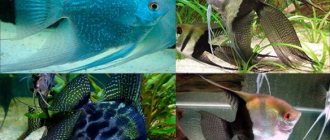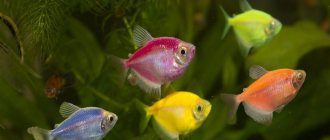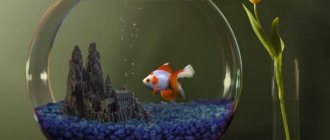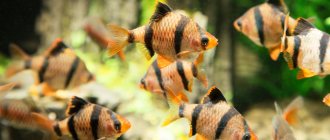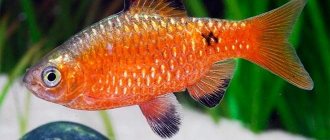Description
The maximum size of the fish is 3 cm. These small predators are in demand among aquarists. Dwarf tetradons prove that in a small aquarium you can keep not only guppies, but also more exotic and unusual species of fish.
Appearance
The body of the tetradon is drop-shaped, with sharp spines that protect the fish in times of danger. The dwarf pufferfish has large eyes that can rotate in different directions. The color changes depending on the mood: from green to brown with dark spots. The abdomen is white or slightly yellow.
Behavior
Dwarf fish are very smart. If the tetradon senses danger, it swells, acquiring a spherical shape and protruding needles. Pygmy predators love to hunt for live food. They are aggressive and territorial, keeping in a flock. They don't eat plants.
Lifespan
Small fish live relatively short lives, and the dwarf tetradon is no exception. With good maintenance and care, the tetradon will live for 5 years.
What to feed unusual fish
Due to the specifics of nutrition, the content of tetradone can become problematic. The fish by nature is a strict predator. Tetradon does not eat pelleted food or flakes. If the owner insists on such a diet, the tetradon will get sick or die of starvation.
We recommend reading
Oranda fish: red cap in your aquarium
The fish eats exclusively live food, less often ice cream.
For the pet choose:
- small snails - fisa, coil, melania (must be present in the diet constantly);
- Daphnia;
- gammarus;
- bloodworm;
- artemia;
- tubifex;
- maggots;
- koretru.
It is acceptable to feed a soaked, clean earthworm, divided into small parts. If necessary, frozen food is provided, but not all tetradons eat stationary food. The problem is solved by gradual accustoming to this diet - live food is mixed with ice cream and the proportions are changed over time.
Content
Dwarf tetradons are suitable for aquarists with little experience. Mandatory pet care includes maintaining stable water parameters in the aquarium.
Aquarium
For a small flock, a 20-liter container is sufficient. Remember that biological equilibrium is more difficult to establish in small vessels and they require frequent maintenance. Choose rectangular and square shaped aquariums. It is better not to use convex and round containers, since the specific shape of the walls causes stress in the fish.
Water parameters
In nature, tetradon lives in fresh water, so salt, even in small concentrations, is unacceptable. The range of water parameters in which pufferfish feel comfortable is narrow. Avoid sudden changes in temperature and hydrochemical composition of water. Periodically check the water with tests for ammonia compounds, water hardness and acidity. Perform weekly fluid changes of 20% of the total volume.
| Temperature | 23–27 degrees |
| Rigidity | 5–22 dGh |
| Acidity pH | 6–7,5 |
| Water movement | weak |
Plants
A tank with tetradons requires numerous shelters in the form of thickets of aquarium plants. Various, even the most vulnerable species will do:
- Vallisneria;
- elodea;
- nymphea;
- lemongrass;
- ferns;
- duckweed;
- Riccia floating;
- Cryptocoryne.
Provide the plants with enough light. Some species require fertilizing in the form of fertilizers.
Priming
Cover the bottom with small pebbles. To achieve a similarity to the natural habitat, place almond or oak leaves in the aquarium, then the liquid will take on a tea color. Clean the soil with a siphon once a week.
View this post on Instagram
carinotetraodon ❤ #carinotetraodon#travan#carinotetraodontravancoricus#minipufferfish#minipuffer#pufferfish#puffer#fish#tank#fiahtank#tetraodontidae#tetraodontiformes#poissonglobe#poissonballon#globefish#freshwater#estuaire#eaudouce#india#indian
A post shared by LET'S GET THIS BREED (@shrimpette_) on Jul 4, 2018 at 12:45pm PDT
Equipment
Dwarf puffers require a standard set of equipment:
- Filter. Choose a device that provides high-quality filtration and does not have strong water pressure. Use an internal or external filter.
- Compressor. Provides oxygen enrichment of the liquid.
- Heater. Replace as necessary if water temperature drops too low. In the summer, use a cooler or ice bottles to cool the water.
Lighting
Pufferfish are unpretentious to light. The lighting can be bright, the main thing is that the fish have enough shelter and shaded places in the aquarium, then both tetradons and plants will be comfortable.
Scenery
The natural reservoir of dwarf tetradons is recreated by driftwood, stones and grottoes. They will also decorate the aquarium:
- pots;
- homemade decorations from coconut shells;
- ceramic pipes;
- artificial plants.
Be careful with metal and artificially colored elements, they change the composition of the water and are dangerous for fish. Before placing decorative elements in the aquarium, rinse them thoroughly and boil stones and driftwood. Inspect the decorations; they should not have sharp corners or sloppy cuts, otherwise the fish will be injured.
Difficulty in content
This cute, funny fish won't cause you much trouble! The dwarf tetradon is an unpretentious and hardy aquatic inhabitant, the maintenance of which is accessible to absolutely everyone.
Keeping in an aquarium
Water parameters.
- Temperature ranges from 23 to 27°, minimum 19°, maximum 29°.
- General hardness 5–24, carbonate 6–17.
- pH 6.6–7.7.
IMPORTANT!
In nature, the tetradon lives in fresh water, so salt should not be added to the aquarium environment. This will shorten its lifespan. Aquarium dimensions.
This little one doesn't need a huge aquarium! For a flock of 5-6 tetradons, a capacity of 20 liters is sufficient. The form doesn't matter.
Priming.
To bring the conditions closer to natural, you can use river sand mixed with small pebbles.
Plants.
In an aquarium with tetradons, living plants must be present! Moreover, in some corner of the container it is necessary to create dense thickets so that the fish can find reliable shelter there. You can plant any plants, because tetradons do not spoil them at all. Even such delicate plants as lotus and echinodorus will remain unharmed.
Lighting.
Dwarf tetradons do not have any special requirements for lighting, being content with any. However, bright light is necessary for plants to develop well. In addition, in good lighting, small fish look more visible and vibrant.
Filtration.
After eating, tetradons leave a lot of debris. They never pick up food that has fallen to the bottom. Usually such waste is destroyed by snails. But they do not live in an aquarium with small predators. After all, tetradons go on a real hunt for shellfish and don’t rest until they’ve eaten them all.
At the same time, fish are susceptible to an increase in the amount of nitrates and ammonia compounds in the water. The salvation will be a powerful filter, a constant bottom siphon and regular replacement of water by a third of the total volume. It is advisable to carry out cleaning every 7–9 days.
Aeration.
To enrich water with oxygen, a standard compressor is sufficient.
Scenery.
You can use any decorative elements. The main thing is not to get carried away with them, leaving room for the fish to swim freely.
Feeding
In nature, the small predator does not eat plant foods. It looks for small insects, various snails and invertebrate aquatic inhabitants of suitable size.
ATTENTION! A dwarf tetradon will never eat food in the form of pellets, chips, flakes or tablets! With such a diet, he will simply die of hunger.
To feed the tetradon, you should purchase live snails such as melania, coils and physical. Artemia, hamarus, bloodworms and daphnia are also suitable. They can be given frozen. True, small picky eaters are quite capable of ignoring food that does not move. They should be acclimated gradually by mixing frozen food with live organisms.
Small snails should always be present in the diet! They play a very unique role, helping to grind down the rapidly and continuously growing teeth of predatory babies.
Live and frozen food can be purchased at the market or in a specialty store. Its price varies from 25 to 250 rubles depending on the type, weight and region of sale. For example, 30 g of bloodworm will cost 23–35 rubles.
Before giving food to tetradons, it must be disinfected. To do this, you can use ozonation or treatment with chemicals (potassium permanganate, methylene blue, metranidazole, ichthyophore, furazolidone, piperazine).
Compatibility with other fish
Despite their miniature size, tetradons are quite aggressive and conflict-ridden . Their predatory essence manifests itself constantly! They often confuse small fish with food and attack them, biting their sides. They take away food from the larger ones, and they do it quite successfully. Peaceful fish living with tetradons often sport torn fins and damaged scales.
Large predators will most likely hunt the babies from India themselves. As a result, everyone will suffer! The tetradons will die themselves and kill the aggressor who ate them. They swell in the stomach and clog the predator's digestive tract.
You can combine tetradons with large non-aggressive and herbivorous fish and shrimp.
List of compatible fish.
- Rainbows
- Otocinclus
- Danio
- Rasbora Espey
- Cherry and Amano shrimp
- Ramiresi
- Discus
List of incompatible fish.
- Veil fish
- Small shrimp
- Guppies and platies
- Cichlids
- Fighting fish
- Predatory catfish
Diseases
This small predator gets sick very rarely. Most often, the cause of illness is improper care and poor living conditions.
Poisoning with ammonia compounds.
The gills suffer the most; they become inflamed, turn red and increase in size. The fish breathes with difficulty and prefers to stay close to the surface.
The problem can be eliminated by installing a good filter, frequent water changes, siphoning the bottom and adding zeolite to the water - a drug that absorbs excess ammonia.
Nitrate poisoning.
A sick fish first becomes agitated, moves erratically, and reacts to the slightest stimuli. Then convulsions develop, the tetradon goes to the bottom. All his fins and gills are spread out, his mouth is open.
Sick fish should be immediately placed in a temporary aquarium with clean water, and in a permanent aquarium, thoroughly siphon the bottom, replace half of the water with fresh water, rinse the filter and add substances that neutralize nitrates.
Dropsy.
The tetradon's abdomen is strongly inflated, and its scales are raised. The color loses intensity and brightness. Most likely, your tetradon is lacking food. Increase the diet, improve its quality, switch the fish only to live food and be sure to feed snails.
Lifespan
If kept in good conditions, the tetradon can live for about 5 years.
Price
The average cost of a young tetradon varies from 80 to 160 rubles. More adult individuals, reaching 3 cm in length, are sold for 200–280 rubles.
Feeding
Dwarf fish eat live food and do not accept dry food. The diet should include:
- small bloodworm;
- tubifex;
- small snails (coil, physa, melania);
- coretra;
- gammarus for fish;
- daphnia;
- squid;
- earthworms;
- brine shrimp
Serve snails regularly. Using snail shells, pufferfish wear down their rapidly growing teeth. Breed shellfish in a separate container, so tetradon will have an important component of the diet. Remember that large snails are not suitable. If your dwarf fish refuses frozen food, mix it with live food, pre-treating it in a solution of potassium permanganate, methylene blue or piperazine. Feed the fish 1-2 times a day in portions that are eaten within 2-3 minutes.
Where and how does it live in nature?
This fish lives in India, lives in the Pamba River. Sometimes found in a lake into which a river flows. Unlike other types of tetradons, the dwarf is a freshwater fish. Aquatic plants grow abundantly in the natural habitat. The sandy bottom is covered in places with a thick layer of silt.
The river and lake are distinguished by calm waters without strong currents. The inhabitants swim among driftwood and plants, looking for insects, crustaceans and, especially, snails, which they love to eat. Tetradons often settle in shallow waters near the shores. These fish are loners. Sometimes they gather in groups of 2-3 individuals, but do not form flocks.
We recommend reading
Glass aquarium fish
Compatibility
It is better to stock dwarf predators in a species aquarium. Tetradons may be compatible with herbivorous, non-aggressive aquarium inhabitants:
- zebrafish;
- iris;
- rasborami;
- corridors;
- neon.
Large species of shrimp, such as amano and cherry shrimp, are suitable for living together. You cannot house dwarf tetradons with large fish and those with long fins. Guppies, goldfish, cichlids are unsuccessful bedfellows.
Description of the appearance of the fish
The popularity and demand of dwarf tetradons is largely due to their attractive appearance. The fish have a pear-shaped body , which smoothly turns into a large head. The body is dense, there are small spines that are invisible when the tetradon is in a calm state. Because of them, representatives of the family were called puffers.
If the fish is frightened or anxious, it inflates, takes on a spherical shape, and the spines turn out to be a protective device. However, if an individual transforms frequently, its health may deteriorate significantly. Therefore, you should not scare your pet into pouting.
Yellow tetradon is a tiny fish, reaching a length of 2.5 cm. It has a weakly defined anal fin , while the rest have the appearance of soft rays. Relative to the body, they look miniature and agile, like the wings of a tiny hummingbird. Individuals have rather large, expressive eyes , very mobile. But if they are interested in something, they are able to remain motionless for a long time.
The owners of these extraordinary fish are captivated by their behavior - when they see the owner, they swim up to the glass and begin to carefully examine it. They are also capable of playing and begging for food, making them similar to other pets where such behavior is expected.
mouth is shaped like a bird's beak; their premaxillary and jaw bones are fused. Dwarf tetradons are predators and have 4 plates of teeth, which are located below and above.
Aquarists who first purchased fish of this breed and put them into the tank may notice that their tail is bent. This is a normal phenomenon and signals a protective reaction of individuals. When the new inhabitants get comfortable and become familiar with the territory and the owner, this feature will disappear. In the future, the fish will bend their tail during sleep and rest, or when looking at unfamiliar objects.
Reproduction
Tetradons are easy to propagate in an aquarium. A spawning tank will be required to preserve the offspring. Create good conditions in the spawning tank. Install a filter that will not suck in the fry or create a strong flow of water. Plant the plants.
Sex differences
Distinguish males from females by their deeper coloration and dark line on the belly. Sometimes the fins of males turn yellow. Females are larger and plumper than males.
View this post on Instagram
Analyzing their dots to try to recognize them a little #carinotetraodon#travan#carinotetraodontravancoricus#minipufferfish#minipuffer#pufferfish#puffer#fish#tank#fiahtank#tetraodontidae#tetraodontiformes#poissonglobe#poissonballon#globefish#freshwater#estuaire#eaudouce#india#indian
A post shared by LET'S GET THIS BREED (@shrimpette_) on Jul 5, 2018 at 4:00pm PDT
Spawning
A couple of weeks before spawning, feed your fish nutritious live food. Place a pair or group of fish, where there will be 1 male and several females. Tetradons spawn on plant leaves and soil. From one female you can get up to 10 eggs.
After laying the eggs, release the parents. The fry appear after 3–5 days. Starter feed:
- microworms;
- ciliates;
- Artemia nauplii;
- small snails;
- frozen food.
If several generations are growing together, sort the fry by size, as the larger ones may eat the smaller ones. By two months the fry grows to 1 cm.
View this post on Instagram
#aquarium .#aquarium .#tetradon.#tetradon .#carinotetraodontravancoricus .#dwarf tetradon#thundersnails .#snail hunter.#snail eater.#snail destroyer.#snails in aquarium
A post shared by aqualiveplants (@aqualiveplants) on Jun 28, 2015 at 12:38pm PDT
Diseases
The dwarf predator has a strong immune system and rarely gets sick. A common cause of the disease is incorrect water parameters and feeding, and lack of aquarium hygiene.
Ammonia poisoning
Pufferfish produce a lot of waste, so failure to clean the aquarium on time can cause excess ammonia, which is dangerous for the fish. When poisoned, the gills are inflamed and red. Immediately clean up the aquarium and check the water for dangerous compounds. Smoothly improve water quality.
Nitrate poisoning
When poisoned by nitrates, tetradon becomes restless and fussy. The gills and fins are spread out, the fish is greedily trying to breathe. A sick individual can be placed in an aquarium with clean water with similar parameters. Carry out general cleaning in the general aquarium, check the water for nitrates.
Dropsy
The abdomen of the dwarf predator swells, the color fades. Often the disease is caused by poor quality food. Review your fish's diet.
Photo
Adviсe
- Do not provoke fish to swell into a ball, because this is a protective mechanism that is accompanied by severe stress. Do not disturb the fish unless necessary, do not knock on the glass or touch them.
- If the fish behave like spawning, but you do not see eggs, walk along the ground with a small hose. There will be eggs among the drained water.
- Store-bought frozen food is not the best option, since the aquarist has no knowledge of the quality of the food and how it was stored. A safe option is to make homemade frozen food. Freezing as a method of processing fish food is very effective.
- Wash your hands when handling the aquarium. Cleaning equipment must be free of traces of detergents.
Dwarf tetradons are said to be poisonous. Large animals that eat them die due to the poisonous mucus or fish needles. If you need to come into contact with tetradon, make sure that there are no scratches or other damage on your hands.
Previous
FishMelanochromis auratus - American aggressive cichlid
Next
FishDoctor Garra Rufa Fish
What is a dwarf tetradon?
It is also called yellow. This is the smallest representative of the species. Reaches a size of 1.5-2.5 cm. The color is most often bright yellow with spots, less often yellow-greenish, yellow-brownish with spots. The body of the fish is pear-shaped, elongated. It is difficult to distinguish a female from a male. The latter sometimes have a dark stripe on the abdomen, and the body is less rounded.
In case of danger, the tetradon fills with water or air and turns into a funny sphere. This is a defense mechanism.
Another notable feature is the large, expressive eyes. The fish can rotate them in different directions independently of each other.
Interestingly, a close relative of the tetradon is the puffer fish. The same deadly fish that inspires fear among gourmets. Many people are afraid to deal with tetradons for this reason. However, although scientists have different opinions about the presence of poison in a small fish (some believe that the mucus does not contain toxins, others believe that the fish secretes a very weak poison in small quantities), such a pet is safe for humans. There has not been a single case of poisoning from contact with this creature.
